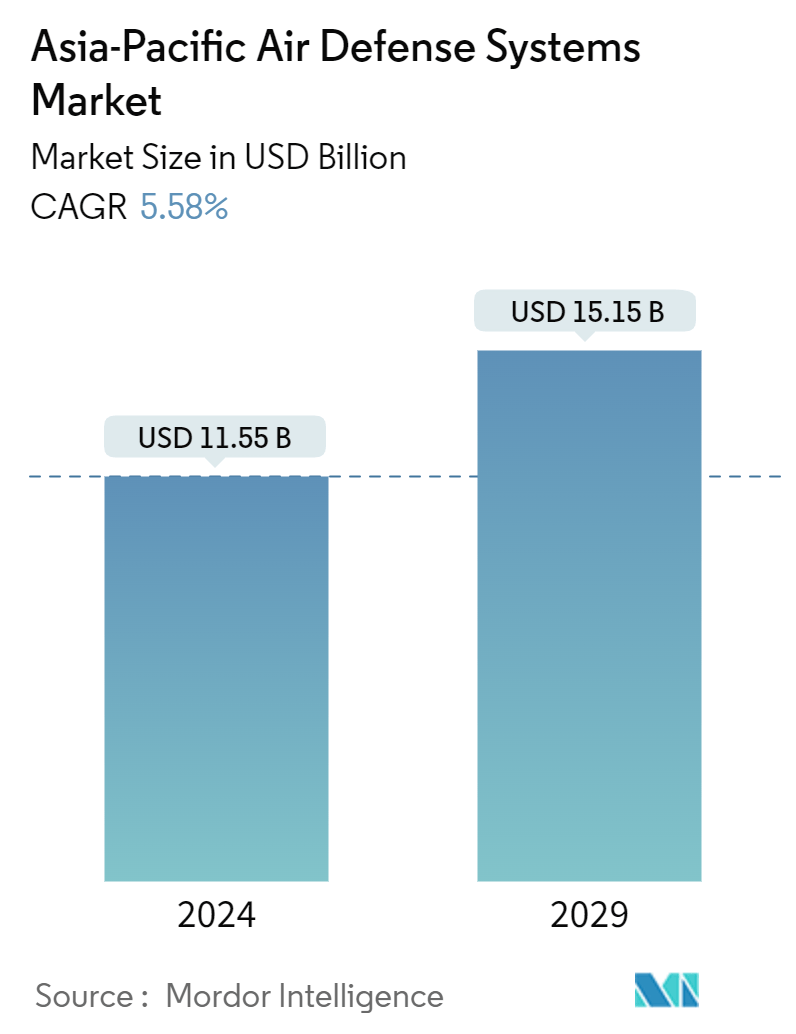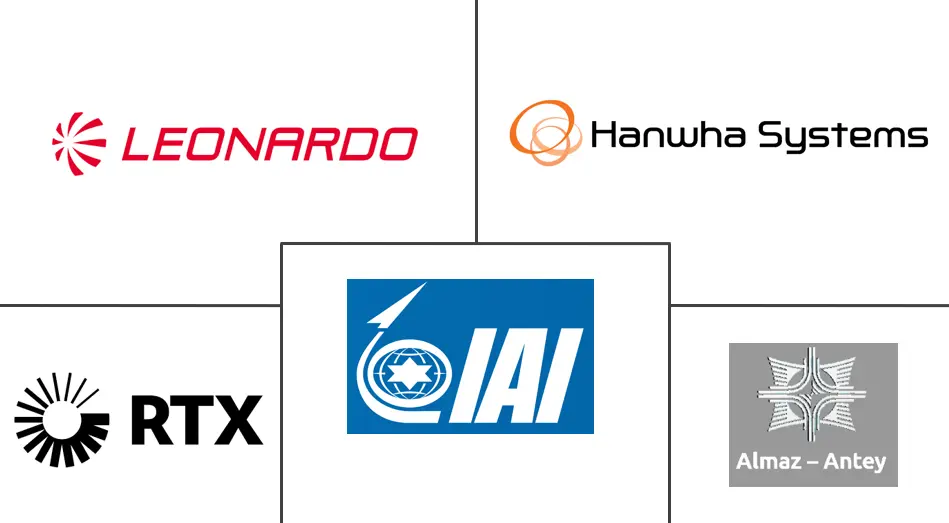Market Size of Asia-Pacific Air Defense Systems Industry

| Study Period | 2019 - 2029 |
| Base Year For Estimation | 2023 |
| Market Size (2024) | USD 11.55 Billion |
| Market Size (2029) | USD 15.15 Billion |
| CAGR (2024 - 2029) | 5.58 % |
| Market Concentration | Medium |
Major Players
*Disclaimer: Major Players sorted in no particular order |
Asia-Pacific Air Defense Systems Market Analysis
The Asia-Pacific Air Defense Systems Market size is estimated at USD 11.55 billion in 2024, and is expected to reach USD 15.15 billion by 2029, growing at a CAGR of 5.58% during the forecast period (2024-2029).
Recent years have witnessed a transformation in air-based warfare, marked by the emergence of lethal, agile, and often untraceable autonomous threats. In response to these escalating threats, nations worldwide are intensifying efforts to fortify their air defense capabilities. Heightened geopolitical conflicts and border tensions have led countries to boost military spending, channeling significant investments into air defense systems. This surge in military expenditure is, in turn, fueling the demand for air defense systems in the Asia-Pacific region.
Technological advancements, especially the rise of sophisticated threats like hypersonic missiles, underscore the urgent need for enhanced air defense systems. In response, companies are innovating and developing advanced detection and countermeasure systems to address threats from UAVs, aircraft, missiles, rockets, artillery, and mortars.
Yet, the market faces challenges: high R&D costs and extended development cycles make players vulnerable to global economic fluctuations.
Asia-Pacific Air Defense Systems Industry Segmentation
Air defense systems include all the radars and interceptors used by air, land, and sea platforms to detect and destroy incoming threats of missiles (ballistic and cruise), aircraft, UAVs, rockets, artillery, and mortars. The study also includes MANPADs, pedestal-mounted MANPADs, and remote weapon stations that can defend against incoming airborne threats by automatically tracking, targeting, and firing.
The Asia-Pacific air defense systems market is segmented by platform, range, and geography. By platform, the market is segmented into land-based, air-based, and sea-based. By range, the market is segmented into long-range, medium-range, and short-range. The report also offers the market size and forecasts for five countries across the region. For each segment, the market sizing and forecasts have been done based on value (USD).
| Platform | |
| Land-based | |
| Air-based | |
| Sea-based |
| Range | |
| Long-range | |
| Medium-range | |
| Short-range |
| Geography | |
| China | |
| India | |
| Japan | |
| South Korea | |
| Australia | |
| Rest of Asia-Pacific |
Asia-Pacific Air Defense Systems Market Size Summary
The Asia-Pacific air defense systems market is experiencing significant growth, driven by the evolving nature of air-based warfare and increasing geopolitical tensions in the region. As countries face more sophisticated and autonomous threats, there is a heightened emphasis on enhancing air defense capabilities. This has led to increased military expenditure, particularly in nations such as China, India, Japan, and South Korea, which are investing heavily in advanced air defense systems to safeguard their territories. The demand for these systems is further propelled by technological advancements, including the development of hypersonic missiles and advanced threat detection systems, which are essential for countering a wide range of aerial threats.
The market is characterized by a semi-consolidated structure, with both local and international players actively participating. Prominent companies such as Almaz-Antey Corp., IAI, RTX Corporation, Leonardo SpA, and Hanwha Systems are key contributors to the market. The dominance of the land segment is expected to continue, supported by initiatives like India's indigenously developed ballistic missile defense system and Taiwan's mass production of the TC-2 air defense system. China's substantial military spending, guided by its strategic five-year plan, is driving the development of advanced weapon systems, including high-energy laser weapons. These developments, along with increased investments in local manufacturing, are anticipated to bolster the market's growth during the forecast period.
Asia-Pacific Air Defense Systems Market Size - Table of Contents
-
1. MARKET DYNAMICS
-
1.1 Market Overview
-
1.2 Market Drivers
-
1.3 Market Restraints
-
1.4 Porter's Five Forces Analysis
-
1.4.1 Threat of New Entrants
-
1.4.2 Bargaining Power of Buyers/Consumers
-
1.4.3 Bargaining Power of Suppliers
-
1.4.4 Threat of Substitute Products
-
1.4.5 Intensity of Competitive Rivalry
-
-
-
2. MARKET SEGMENTATION
-
2.1 Platform
-
2.1.1 Land-based
-
2.1.2 Air-based
-
2.1.3 Sea-based
-
-
2.2 Range
-
2.2.1 Long-range
-
2.2.2 Medium-range
-
2.2.3 Short-range
-
-
2.3 Geography
-
2.3.1 China
-
2.3.2 India
-
2.3.3 Japan
-
2.3.4 South Korea
-
2.3.5 Australia
-
2.3.6 Rest of Asia-Pacific
-
-
Asia-Pacific Air Defense Systems Market Size FAQs
How big is the Asia-Pacific Air Defense Systems Market?
The Asia-Pacific Air Defense Systems Market size is expected to reach USD 11.55 billion in 2024 and grow at a CAGR of 5.58% to reach USD 15.15 billion by 2029.
What is the current Asia-Pacific Air Defense Systems Market size?
In 2024, the Asia-Pacific Air Defense Systems Market size is expected to reach USD 11.55 billion.

